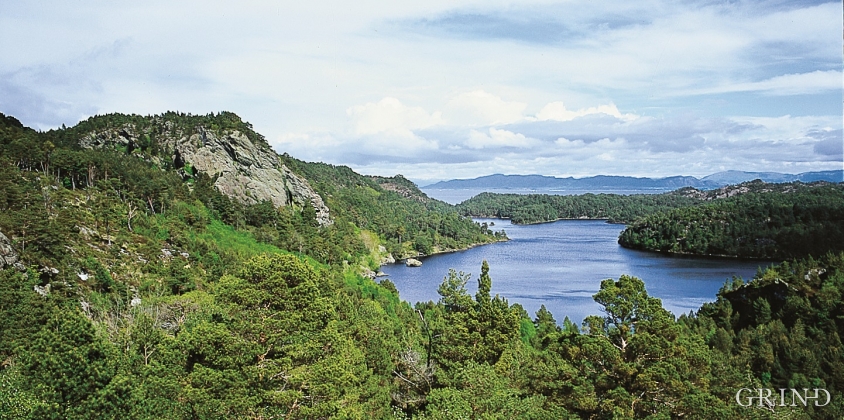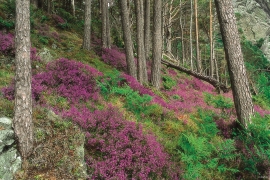Published: 21.07.2015 | Author: Bjørn Moe
PINE FOREST IN THE WEST
You have to travel to Scotland in order to find pine forests similar to those at Bømlo. The nearness to the sea has contributed in different ways to shaping one of the westernmost pine forests in Norway.
Along the east side of the stretch of highway between Kuleseid and Langevåg is a large, nearly continuous area with pine forest in a terrain that spans from wind-exposed ridges to sheltered, small valleys. The forest is scattered and is difficult to access by forest roads. Therefore, it has been little exploited by the modern timber industry. The name "Sagvatnet" reflects that there was timber activity in past times. There is much evidence that the forest was cleared about a hundred years ago.
he old carraige road from the farm by Berge goes through old pastures in an idyllic cultural landscape, that is now in danger of being overgrown with hazel and juniper. From the open cultural landscape one can follow a well prepared trail into the pine forest along Bergesvatnet lake. On this nutrient rich soil, the trees grow high and have thick, straight trunks. Holly is common, and English ivy climbs up both tree trunks and rock walls. These winter-green species thrive in this climate where there is little frost. Some of the winter-green fern species can also be found; for example, the common deer fern and rarer species, such as the Hard Shield Ferns and black spleenwort.
Between Bergesvetnet lake and Tjongspollen lies Skogafjellet. Judging from the name one would expect that there was more forest here than elsewhere in the district. On top of the mountain there is a pine forest that is quite different than down by Bergesvatnet Lake. The trees up here have been strongly affected by the wind and weather. They often have shorter trunks and longer branches, that gives them a wide and rather flat-shaped crown. Here, there are strong local variations between the trees that are situated up on the mountaintops and those down in the valleys. As the terrain gets higher, the trees become shorter. In this way, the tree crowns lie at roughly the same height. This continuous, flat crown cover makes it difficult for the wind to get a proper hold. The pine forest thus is well protected from the forces of wind and storms. One seldom sees trees that are blown off their roots.
On the top of Skogafjellet, the soil does not receive weathered material, and a lot of humus collects to make the ground acidic. It is heather that dominates on the forest floor. Especially in drier places, there is much twisted heath, a species that is more common on the heather moors than in forest. Only in the forests nearest to the sea will one find much twisted heath in the forest vegetation.
- Brekke, H.; Amaliksen, K. G.; Færseth, R. B.; Jorde, K.; Naterstad, J.; Nilsen, E.; Nordås, J.; Ragnhildstveit,J.; Ree, R. 1993. Geologisk kart over Norge, berggrunnskart Bømlo – M 1:50.000, svart/kvitt. Norges geologiske undersøkelse.
- Fremstad, E.; Moen A. 2001. Truete vegetasjonstyper i Norge. Norges teknisk-naturvit. univ. Vitenskapsmus. Rapport botanisk serie 2001–4.
- Moe, B. 2001. Inventering av verneverdig barskog i Hordaland. Fylkesmannen i Hordaland. MVA-rapport 2.





